Tom Homan Was Said to Have Received $50,000 From Agents. He May Not Have to Return It.

© Kent Nishimura for The New York Times

© Kent Nishimura for The New York Times
When a group of devils armed with long hooks threatens Dante, Virgil hurries him along towards the next rottenpocket in Hell. They work their way around some of the damage wrought by Christ’s harrowing of Hell following his crucifixion. With those devils still hanging around, they then reach a pit of boiling tar, in which the spirits of barrators are trapped. These had traded in public office and bought influence in courts of law.
The devils pull out one of the souls for Dante and Virgil to talk to, but quickly return to hacking with their hooks.


Unlike others, he springs free and escapes their lunges as he plunges back into the pitch.


Dante and Virgil leave the devils attacking other barrators, and walk on in silence. Dante reflects on one of Aesop’s fables about the frog, the rat and the hawk. He blames himself for the tormenting of the devils behind them, but as he looks back he sees them on the wing again heading towards them. As they cross into the next rottenpocket, they realise the pack of devils can’t pursue them beyond that point.
Next are hypocrites, who are dressed up in hooded habits like monks. Although those are coloured bright gold, they’re weighted with lead, forcing the hypocrites into eternal labour against the mass of their clothes.

Dante meets two Bolognese friars, Catalano de’ Malavolti and Loderingo degli Andalò, who formed a fake religious order. They point out a figure staked out naked on the ground, who is Caiaphas, the High Priest of Jerusalem who advised scribes and pharisees that Christ’s death would be a good solution.


Virgil moves Dante on towards the damaged crossing to the next rottenpocket for thieves. After negotiating their descent, Dante sees its pit full of snakes, binding the hands of the souls there and covering their naked bodies.



A snake strikes one of the sinners at the back of the neck, causing the ghost to burst into flames then turn into ash, which falls onto the ground and reconstitutes itself.


There they talk with one of the thieves by the name of Vanni Fucci, a black Guelph from Pistoia near Florence who had stolen holy objects from a chapel and betrayed an accomplice for execution in his place. The snakes then take charge of him, winding their coils around his neck and body, and putting him into a reptile straightjacket.
Dante and Virgil move on and meet a centaur.
The artists
William Blake (1757–1827) was a British visionary painter and illustrator whose last and incomplete work was an illustrated edition of the Divine Comedy for the painter John Linnell. Most of his works shown in this series were created for that, although he did draw and paint scenes during his earlier career. I have a major series on his work here.
Gustave Doré (1832–1883) was the leading French illustrator of the nineteenth century, whose paintings are still relatively unknown. Early in his career, he produced a complete set of seventy illustrations for translations of the Inferno, first published in 1857 and still being used. These were followed in 1867 by more illustrations for Purgatorio and Paradiso. This article looks at his paintings.
John Flaxman (1755–1826) was a British sculptor and draughtsman who occasionally painted too. When he was in Rome between 1787-91, he produced drawings for book illustrations, including a set of 111 for an edition of The Divine Comedy. In 1810, he was appointed the Professor of Sculpture to the Royal Academy in London, and in 1817 made drawings to illustrate Hesiod, which were engraved by William Blake.
Joseph Anton Koch (1768-1839) was an Austrian landscape painter, who worked mainly in Neoclassical style. During his second stay in Rome, he was commissioned to paint frescos in the Villa Massimi on the walls of the Dante Room there, which remain one of the most florid visual accounts of Dante’s Inferno. He completed those between 1824-29. He also appears to have drawn a set of illustrations for Dante’s Inferno in about 1808.
Bartolomeo Pinelli (1781-1835) was a Roman illustrator and engraver who provided illustrations for a great many books, and specialised in the city of Rome. He made 145 prints to illustrate Dante’s Divine Comedy, most probably in the early nineteenth century.
Jan van der Straet, also commonly known by his Italianised name of Giovanni Stradano (1523-1605), was a painter who started his career in Bruges and Antwerp in Belgium, but moved to Florence in 1550, where he worked for the remainder of his life. Mannerist in style, he worked with printmakers in Antwerp to produce collections of prints, including an extensive set for The Divine Comedy.
References
Robin Kirkpatrick (trans) (2012) Dante, The Divine Comedy, Inferno, Purgatorio, Paradiso, Penguin Classics. ISBN 978 0 141 19749 4.
Richard Lansing (ed) (2000) The Dante Encyclopedia, Routledge. ISBN 978 0 415 87611 7.
Guy P Raffa (2009) The Complete Danteworlds, A Reader’s Guide to the Divine Comedy, Chicago UP. ISBN 978 0 2267 0270 4.
Prue Shaw (2014) Reading Dante, From Here to Eternity, Liveright. ISBN 978 1 63149 006 4.
From their tragic encounter with tormented souls in the Suicide Wood, Virgil leads Dante onto a barren and sandy plain, where groups of spirits are in different postures, naked under steady showers of flakes of fire. These fall on their flesh, and set the sand afire underneath them. They are being punished for their differing acts of violence against God: blasphemers lie flat on their backs, sodomites are moving at all times, and usurers crouch with purses strung from their necks.

The two talk with Capaneus, a huge man who was once a powerful king and waged war against the city of Thebes, and a blasphemer who was struck by a thunderbolt for his arrogance towards the (classical and pagan) gods.

Among the sodomites is the prominent Guelph encyclopaedist Brunetto Latini (c 1220-94), who may well have been Dante’s mentor at one time. Also identified are Priscian a Latin grammarian, Francesco d’Accorso a legal scholar, and Andrea de’ Mozzi a bishop of Florence, together with three other Florentines.
Virgil explains some more of the topography of Hell, how waters originating from a statue on Mount Idaeus (Ida) on the island of Crete flow down to form its three principal rivers, the Acheron, Styx and Phlegethon. The statue of the Old Man of Crete has a gold head, silver arms, brass torso, and iron below, apart from a terracotta foot. This follows the mythical ‘ages of mankind’ in descent, and its tears feed the waters of Hell.


Dante is next led down towards a vile monster with the face of an honest man but the body of a serpent, its body seemingly tattooed with knots and whorls, and a sting at the end of its great tail: this is Geryon, in classical myth a cruel king who was killed by Hercules, and here forming an image of fraud.
Before reaching that monster, the pair see some usurers on the ground. They are identified as contemporary members of prominent Florentine and Paduan families known for their riches and usury.

Virgil then jumps onto Geryon’s back, and encourages Dante to have courage to join him there. Once they have both boarded, Virgil tells Geryon to fly off, and the monster carries them down through a hundred spiralling turns to the foot of a high cliff.






Virgil and Dante have now descended to circle eight.
The artists
William Blake (1757–1827) was a British visionary painter and illustrator whose last and incomplete work was an illustrated edition of the Divine Comedy for the painter John Linnell. Most of his works shown in this series were created for that, although he did draw and paint scenes during his earlier career. I have a major series on his work here.
Gustave Doré (1832–1883) was the leading French illustrator of the nineteenth century, whose paintings are still relatively unknown. Early in his career, he produced a complete set of seventy illustrations for translations of the Inferno, first published in 1857 and still in current use. They were followed in 1867 by more illustrations for Purgatorio and Paradiso. This article looks at his paintings.
John Flaxman (1755–1826) was a British sculptor and draughtsman who occasionally painted too. When he was in Rome between 1787-91, he produced drawings for book illustrations, including a set of 111 for an edition of The Divine Comedy. In 1810, he was appointed the Professor of Sculpture to the Royal Academy in London, and in 1817 made drawings to illustrate Hesiod, which were engraved by William Blake.
Joseph Anton Koch (1768-1839) was an Austrian landscape painter, who worked mainly in Neoclassical style. During his second stay in Rome, he was commissioned to paint frescos in the Villa Massimi on the walls of the Dante Room there, which remain one of the most florid visual accounts of Dante’s Inferno. He completed those between 1824-29. He also appears to have drawn a set of illustrations for Dante’s Inferno in about 1808.
Bartolomeo Pinelli (1781-1835) was a Roman illustrator and engraver who provided illustrations for a great many books, and specialised in the city of Rome. He made 145 prints to illustrate Dante’s Divine Comedy, most probably in the early nineteenth century.
Francesco Scaramuzza (1803–1886) was an Italian painter who specialised in mythological and historical narratives. He became obsessed with Dante’s Divine Comedy, and for much of his career worked on producing paintings and drawings of its scenes. He worked mainly in Parma, in Italy.
Bertel Thorvaldsen (1770–1844) was the greatest Danish sculptor, and one of the foremost in Europe. He worked most of his life in Italy, although the Thorvaldsens Museum with much of his work is in the city of Copenhagen, in a place of honour by the Christiansborg Palace. From humble origins, he trained at the Royal Danish Academy of Art, where he was extremely successful. He arrived in Rome in 1797, and remained there until 1838, when he was welcomed as a returning hero in Copenhagen.
References
Robin Kirkpatrick (trans) (2012) Dante, The Divine Comedy, Inferno, Purgatorio, Paradiso, Penguin Classics. ISBN 978 0 141 19749 4.
Richard Lansing (ed) (2000) The Dante Encyclopedia, Routledge. ISBN 978 0 415 87611 7.
Guy P Raffa (2009) The Complete Danteworlds, A Reader’s Guide to the Divine Comedy, Chicago UP. ISBN 978 0 2267 0270 4.
Prue Shaw (2014) Reading Dante, From Here to Eternity, Liveright. ISBN 978 1 63149 006 4.
Virgil has led Dante into a gorge taking them from the heretics further into the depths of Hell. As they descend, Virgil advises they should take their time so they can become accustomed to the stench emanating from these depths. This allows him to explain to Dante the layout of the parts they are about to enter.
Within the next pit are three sub-divisions, catering for the sins of malice in their different forms. The first ring is for those of violent will, and is divided again into three, for homicides and bandits, for suicides, and blasphemers. Dante’s verbal descriptions of these sub-divisions can readily become confusing, and have been turned into diagrammatic maps by several artists.

One of the most famous is Botticelli’s Map of Hell from 1480-90, in which these lower zones are shown as a funnel at the bottom, leading to the Devil himself.

Jan van der Straet’s diagram from 1587 is similar in form, and packs these zones into the narrow section at the foot.

Dante opens Canto 12 as the pair are scrambling down boulders as if in the Alps, dislodged during the earthquake resulting from Christ’s harrowing of Hell, to meet the Minotaur from Crete.



Like so many of Dante’s beasts, the Minotaur is drawn from classical mythology. This monstrous cross between a bull and human was kept in the labyrinth on Crete, where it was periodically fed with young Greek men and virgin women. For George Frederic Watts, in his painting of The Minotaur from 1885, it represented the worst of Victorian society and its moral values, in the industry of child prostitution flourishing in London at the time.
Dante and Virgil hurry past the Minotaur when they can, and continue their descent through more fallen boulders and scree, to enter the seventh circle, for sins of violence. They are then hailed by one of a group of centaurs armed with bows and arrows. Virgil responds that they will discuss their mission with Chiron, rather than the hot-headed Nessus. Chiron was a centaur in mythology, but one known for his wisdom, and for teaching the young Achilles. Nessus was another centaur, who tried to abduct Heracles’ wife Deianeira and was killed for that, but laid a plot that led to Heracles’ death.

Chiron directs Nessus to aid Virgil and Dante in their passage.

They pass along the rocks beside the damned souls, who are immersed in boiling blood to a depth appropriate to their sins. Dante recognises some as they go: Alexander the Great, Dionysius the Elder and tyrant of Syracuse, one of the d’Este family who was suffocated by his own son. Further on are Attila the Hun, Pyrrhus, Sextus son of Pompey, and a couple of infamous contemporary highwaymen.
Virgil then leads Dante into a strange wood, whose thorn trees form the nests of Harpies. These composite creatures have the heads of humans and the bodies and talons of birds, and live in sub-ring number two. In classical legend, the Harpies inhabited the Strophades, islands where they attacked Aeneas and his companions in Virgil’s Aeneid.


Virgil tells Dante to break a small branch from one of the trees. When he does, the tree screams out in pain, and the wound oozes blood. The tree explains that they were once people, but had taken their own lives. In this case, Dante is talking to the poet Pier della Vigna, who was ruined by envious rivals.


Dante is filled with pity for the spirit, who can only look forward to the Day of Judgement, while they are tortured by the Harpies feeding on their leaves. After learning of another two suicides from Siena and Florence, Dante moves on in profound sorrow.
The artists
William Blake (1757–1827) was a British visionary painter and illustrator whose last and incomplete work was an illustrated edition of the Divine Comedy for the painter John Linnell. Most of his works shown in this series were created for that, although he did draw and paint scenes during his earlier career. I have a major series on his work here.
Sandro Botticelli (1445–1510) was one of the leading painters of the early Southern Renaissance, working in his native city of Florence. In addition to his huge egg tempera masterpieces of Primavera (c 1482) and The Birth of Venus (c 1485), he was a lifelong fan of Dante’s writings. He produced drawings that were engraved for the first printed edition of the Divine Comedy in 1481, but these weren’t successful, most copies only having two or three of the 19 engraved. He later began a manuscript illustrated edition on parchment, but few pages were ever fully illuminated.
Gustave Doré (1832–1883) was the leading French illustrator of the nineteenth century, whose paintings are still relatively unknown. Early in his career, he produced a complete set of seventy illustrations for translations of the Inferno, first published in 1857 and still continuing in use. These were followed in 1867 by more illustrations for Purgatorio and Paradiso. This article looks at his paintings.
John Flaxman (1755–1826) was a British sculptor and draughtsman who occasionally painted as well. When he was in Rome between 1787-91, he produced drawings for book illustrations, including a set of 111 for an edition of The Divine Comedy. In 1810, he was appointed the Professor of Sculpture to the Royal Academy in London, and in 1817 made drawings to illustrate Hesiod, that were engraved by William Blake.
Joseph Anton Koch (1768-1839) was an Austrian landscape painter, who worked mainly in Neoclassical style. During his second stay in Rome, he was commissioned to paint frescos in the Villa Massimi on the walls of the Dante Room there, which remain one of the most florid visual accounts of Dante’s Inferno. He completed those between 1824-29. He also appears to have drawn a set of illustrations for Dante’s Inferno in about 1808.
Jan van der Straet, also commonly known by his Italianised name of Giovanni Stradano (1523-1605), was a painter who started his career in Bruges and Antwerp in Belgium, but moved to Florence in 1550, where he worked for the remainder of his life. Mannerist in style, he worked with printmakers in Antwerp to produce collections of prints, including an extensive set for The Divine Comedy.
References
Robin Kirkpatrick (trans) (2012) Dante, The Divine Comedy, Inferno, Purgatorio, Paradiso, Penguin Classics. ISBN 978 0 141 19749 4.
Richard Lansing (ed) (2000) The Dante Encyclopedia, Routledge. ISBN 978 0 415 87611 7.
Guy P Raffa (2009) The Complete Danteworlds, A Reader’s Guide to the Divine Comedy, Chicago UP. ISBN 978 0 2267 0270 4.
Prue Shaw (2014) Reading Dante, From Here to Eternity, Liveright. ISBN 978 1 63149 006 4.
展开讲讲 · 81 · 脱口秀英雌传:女性如何用笑声改写叙事
这一期播客,我很喜欢。梳理最近几年(2017 – )大陆女性在脱口秀节目中的脉络和演变。
我并不是一个日常去 fo 脱口秀综艺节目的听众。经常是一些精彩段子传到网上了,我才专门去视频网站看看。所以节目里谈的这些成体系的脉络,大多对我是很陌生的。我也并不知道主播们说的内容是否正确,有没有遗漏或偏颇。但是从这种时间脉络的整理视角中,可以看出,行业、演员、听众、社会环境……的各种时间上的演变,在性别状况领域的一种积极的生长。也能很开心地感受到,当主播们梳理出这些变化时,表现出的兴奋和激情。
最让我感触的点,首先当然是杨笠说的(1:11:50):不需要掌声,不需要笑声,只要大家还在说,
现在这个场子里,有多少伤口正在悄悄愈合,这是血肉正在疯长的声音。
以及说这话的杨笠本人,已经坐在评审席上,让新的演员们觉得有人 “罩” 着,让演员们确信,她们的段子背后的的内涵,评审席上是有人能够理解的,从而形成时间上的代际氛围。
这不是我走的路。但我很开心,看着这一条路被人们越走越通畅。
我最近接触到的一些,走其它路的人。和我的路、和脱口秀或成为网红的路,都不相同,却也是同一个目标,甚至更加努力投入的人。他们的路走的并不顺畅,无论物质还是情绪价值上,都算不上 “成功” 或者仅仅是自洽。我隐约能看到他们的痛苦、茫然、甚至面对那些成功路上的人,会有一些冷眼、批判(很多批判我是很赞同的)、嫉妒。对此我也还不知道如何去剖析和面对,当然也可能都只是我的错觉。总之替人家开心就好。
另一个点(52:30),当女脱口秀演员们,担心自己编成段子的悲惨人生,观众们听了会更偏向心疼难受,而影响演出效果。鲁豫作为评审,说:
你今年讲,其实就比你去年讲、前年讲,要好很多。大家可能还会心疼,但氛围已经好了非常多。观众的接受度和边界,也在被你们一次一次地讲这些话题当中,被拓宽。
我在之前很长一段时间,都困扰于如何和大家的幽默感兼容的问题。这些年几乎每一次聊天讲笑话抖包袱的时候,我都会审视,这是不是一个站在传统男性视角,让女性听着不适的油腻段子。有些笑话被我审查掉了;但有些我觉得还可以说。因为我确实有不少女性朋友,甚至是一直在性别领域努力着的朋友,能够毫不顾忌地互相指出反思不足的朋友,我们之间可以开心地享受一些,表面看起来看是地狱笑话的地狱笑话。
但也有一些时候,我自以为的幽默,仍然会让对方感到不适或反感。其中一些大概是因为大家还不熟,还没有度过性别身份造成的防备。而另一些场景,也只能说,幽默感这个事情,在不同地域、时代、不同个体、不同经历前后,都是不一样的。——如果说性别方面的幽默感隔阂,我没有判断的权利;那么,当我调笑几句哥伦比亚大学运动中的学生,就因此被人归类到警察那一边,甚至被归到香港警察那一边,我觉得这真的不是我这边的幽默感问题了……
当然,在这样的时候,我通常会让步、乃至道歉。尤其在性别场合,我觉得我应当让步,也不介意让步。但我内心始终有一个声音:不是的,大家对幽默的态度不应该是这个样子的。而且,这种关于语言的自我审视,其实和在大陆社交网络下,每一句话都要进行敏感词的自我审视,二者在形式上是很类似的。这确实让我很难受。但如今这个氛围,当大家在性别、政治、阶层、生活方式…等多个维度都需要用三观来寻找同温层的时候,这种纯语言上的不兼容,显然不应该成为权重过大的妨碍社交连接的因素。所以我通常继续在让步;而也有一些时候,确实单纯因为和一些人的语言方式及幽默感上的不兼容而渐行渐远。
所以,当我看到这样一种趋势:有越来越多的人,对着越来越多的,原先的感受更偏向于伤痛、提防的东西,如今可以更多用笑的态度去面对了。我对此非常非常开心。当然,那种关于自我言论油腻性的日常审视,还是要继续(摊手
Dante and Virgil are ferried across the River Styx to land at the entrance to the city of Dis, the lower depths of Hell (circles 6-9), but its gate is slammed shut on Virgil when he tries to secure their admission. He reassures Dante that he has been here once before, but Dante is staring at the top of the gate where the three Furies have appeared, wreathed in snakes.


Virgil names them to Dante: Megaera on the left, Alecto to the right, and Tisiphone between them. Megaera represents evil deeds, Tisiphone evil words, and Alecto evil thought. They are another crossover drawn from classical mythology into Dante’s Christian Hell.

The Furies call on Medusa to turn Dante to stone with the sight of her face, and Virgil makes Dante turn to look away from them, and close his eyes tightly.


A strong wind then blows across the marsh of the Styx towards them, as a mass of ghosts there part to make way for an angel who walks across the water towards the walls of Dis. Virgil gets Dante to bow in deference to the angel as he passes them by and opens the gate of Dis for them with his rod. The angel chides those inside for their resistance and immediately returns the way he came.


Virgil then leads Dante through the open gate onto a plain, its ground made uneven by the many tombs set in its surface. The stones on top of them are open, revealing flames within, and letting out cries of pain. Virgil explains that these contain heretics and their followers, and that their lids will only be closed with the Final Judgement. By heresy, Dante here means that these sinners denied the immortality of the soul.

Virgil points out the tomb of the Epicureans, then Dante is startled by the appearance of the head and upper body of Farinata degli Uberto in another.



Farinata was the leader of the Ghibellines of Florence, a family grouping that had been fighting against the Guelphs, including Dante himself. The Florentine then asks Dante who his ancestors were, and reveals that he had opposed Dante’s family. With Farinata are the last Holy Roman Emperor Frederick II and Cardinal Octavian, Ottaviano degli Ubaldini, who had been a powerful supporter of the Ghibellines prior to his death in 1273.
With Dante thinking on what he had heard, Virgil leads him into a gorge, in which they descend deeper into Hell.
The artists
William Blake (1757–1827) was a British visionary painter and illustrator whose last and incomplete work was an illustrated edition of the Divine Comedy for the painter John Linnell. Most of his works shown in this series were created for that, although he did draw and paint scenes during his earlier career. I have a major series on his work here.
Gustave Doré (1832–1883) was the leading French illustrator of the nineteenth century, whose paintings are still relatively unknown. Early in his career, he produced a complete set of seventy illustrations for translations of the Inferno, first published in 1857 and still remain in use. These were followed in 1867 by more illustrations for Purgatorio and Paradiso. This article looks at his paintings.
John Flaxman (1755–1826) was a British sculptor and draughtsman who occasionally painted too. When he was in Rome between 1787-91, he produced drawings for book illustrations, including a set of 111 for an edition of The Divine Comedy. In 1810, he was appointed the Professor of Sculpture to the Royal Academy in London, and in 1817 made drawings to illustrate Hesiod, which were engraved by William Blake.
Joseph Anton Koch (1768-1839) was an Austrian landscape painter, who worked mainly in Neoclassical style. During his second stay in Rome, he was commissioned to paint frescos in the Villa Massimi on the walls of the Dante Room there, which remain one of the most florid visual accounts of Dante’s Inferno. He completed those between 1824-29.
Bernardino Poccetti (1548-1612) was an Italian Mannerist painter and print-maker who was born in Florence and painted some magnificent frescoes in the palaces of the richest families there.
John Singer Sargent (1856–1925) was an American painter who worked much of his career in Europe. Trained in Paris, he was a highly successful portraitist in Paris then London. One of the most gifted and prolific painters of the nineteenth century, his work is rich in bravura brushstrokes and highly individualistic. In his later career, he painted large murals on the East Coast of America, including Orestes Pursued by the Furies in Boston, MA, which he started in 1922, and completed in 1925, just prior to his death. Over its 100 square feet of canvas, it shows a young and naked Orestes cowering under the attacks of the Furies, as he tries to run from them.
References
Robin Kirkpatrick (trans) (2012) Dante, The Divine Comedy, Inferno, Purgatorio, Paradiso, Penguin Classics. ISBN 978 0 141 19749 4.
Richard Lansing (ed) (2000) The Dante Encyclopedia, Routledge. ISBN 978 0 415 87611 7.
Guy P Raffa (2009) The Complete Danteworlds, A Reader’s Guide to the Divine Comedy, Chicago UP. ISBN 978 0 2267 0270 4.
Prue Shaw (2014) Reading Dante, From Here to Eternity, Liveright. ISBN 978 1 63149 006 4.
After hearing Francesca’s story in the Second Circle of Hell, for those guilty of the sin of lust, Dante weeps for her and faints. When he comes to, he realises that he has already descended to the Third Circle, where it’s pouring with rain, with snow and huge hailstones falling down in sheets. This soaks the ground, turning it into stinking mud.
He sees Cerberus, the fearsome three-headed canine monster that guards this circle, also soaked by the unceasing rain.


Agostino Carracci’s portrait of Pluto from 1592 shows Cerberus alongside his master, and the god holding the key to his kingdom.





Its heads bare their fangs at Dante, but his guide Virgil scoops up three handfuls of mud and throws them into the mouths of Cerberus to assuage its hunger.


Dante and Virgil walk on the flat plain among the prostrate forms of the gluttons. One of them sits up and accosts Dante, reminding him that they knew one another. He is Ciacco (a nickname, literally ‘Hoggio’), who tells Dante of his suffering there, and the names of five other Florentines of noble rank who are to be found in the lower circles of Hell.

Ciacco then falls flat on his face in the stinking mud to await the Final Judgement.
As Virgil leads Dante down to the next circle, they talk of what will happen when the Apocalypse comes, until they reach the dreaded figure of Plutus.
Cerberus is a good example of the redeployment of pre-Christian mythology into Christian beliefs: it was originally the guardian of the Underworld, as depicted by Carracci, and prevented those within from escaping back to the earthly world. It even features in the twelve labours of Hercules, in which he captured Cerberus. With Virgil’s explicit involvement, Dante here incorporates it into his Christian concepts of the afterlife.
The artists
Giuseppe Arcimboldo (1527–1593) was a highly original and individualistic Italian painter now best known for his portraits consisting of assemblies of fruit, vegetables and other objects to form human images. He also painted more conventional works which are largely forgotten today, and was court painter to the Habsburgs in Vienna and Prague. You can see some of his portraits in this article.
William Blake (1757–1827) was a British visionary painter and illustrator whose last and incomplete work was an illustrated edition of the Divine Comedy for the painter John Linnell. Most of his works shown in this series were created for that, although he did draw and paint scenes during his earlier career. I have a major series on his work here.
Agostino Carracci (1557-1602) was one of the Carracci trio, the others being his brother Annibale and cousin Ludovico, who were largely responsible for the reputation of the School of Bologna in Italy. After working as an engraver, he painted a series of major frescos showing the story of Jason and Medea, and the early history of Rome.
Gustave Doré (1832–1883) was the leading French illustrator of the nineteenth century, whose paintings are still relatively unknown. Early in his career, he produced a complete set of seventy illustrations for translations of the Inferno, first published in 1857 and still in use. These were followed in 1867 by more illustrations for Purgatorio and Paradiso. This article looks at his paintings.
John Flaxman (1755–1826) was a British sculptor and draughtsman who occasionally painted. When he was in Rome between 1787-91, he produced drawings for book illustrations, including a set of 111 for an edition of The Divine Comedy. In 1810, he was appointed the Professor of Sculpture to the Royal Academy in London, and in 1817 made drawings to illustrate Hesiod, which were engraved by William Blake.
Joseph Anton Koch (1768-1839) was an Austrian landscape painter, who worked mainly in Neoclassical style. During his second stay in Rome, he was commissioned to paint frescos in the Villa Massimi on the walls of the Dante Room there, which remain one of the most florid visual accounts of Dante’s Inferno. He completed those between 1824-29.
Philippe Semeria is a young contemporary artist who is an enthusiast for comics and is an aspiring illustrator.
Jan van der Straet, also commonly known by his Italianised name of Giovanni Stradano (1523-1605), was a painter who started his career in Bruges and Antwerp in Belgium, but moved to Florence in 1550, where he worked for the remainder of his life. Mannerist in style, he worked with printmakers in Antwerp to produce collections of prints, including an extensive set for The Divine Comedy.
References
Robin Kirkpatrick (trans) (2012) Dante, The Divine Comedy, Inferno, Purgatorio, Paradiso, Penguin Classics. ISBN 978 0 141 19749 4.
Richard Lansing (ed) (2000) The Dante Encyclopedia, Routledge. ISBN 978 0 415 87611 7.
Guy P Raffa (2009) The Complete Danteworlds, A Reader’s Guide to the Divine Comedy, Chicago UP. ISBN 978 0 2267 0270 4.
Prue Shaw (2014) Reading Dante, From Here to Eternity, Liveright. ISBN 978 1 63149 006 4.
On the face of it, watercolour painting should be the simplest of all the more popular painting media. The paper is both support and ground, the paint layer is thin, with a little binder of gum arabic and a diluent of plain water. Although some have tried using varnish and other protective layers, in the great majority of watercolour paintings, that’s all there is.
In practice, though, as anyone who has taken watercolour painting seriously knows, there’s a great deal more to it. Much of that is hard to see and can only be inferred from images of watercolour paintings.

Raphael’s The Miraculous Draft of Fishes (c 1515-16) is among the earliest large paintings made using opaque watercolour. Because of limitations in the manufacture of paper at the time, it was made on many sheets that have been mounted on canvas. At around 3 x 4 metres (10.5 x 13 feet), it’s huge by any standards, and even today would probably need to be painted on multiple sheets and mounted on added support.
Over three centuries later, the Pre-Raphaelite artist Marie Spartali Stillman painted her watercolours in layers, using a combination of transparent and opaque watercolour on paper that had been hot-pressed to give it a satin-smooth finish. When re-wetted with another layer of wet paint, watercolour usually becomes liquid again, resulting in the layers mixing. Great care and skill is required to apply wet watercolour on dry paint in the way that she did. Even then some paintings simply don’t work, the layers mix and that attempt has to be discarded. When successful, the end result can resemble layered oil paints, which don’t suffer the same problem when dry paint is overpainted.

The Childhood of Saint Cecily (1883) was one of the last paintings Stillman composed when she lived in Florence, as reflected in its idealised Tuscan background. As with so many paintings of saints, it departs from even the most inventive of hagiographies, here for the patron saint of music, Cecilia. The saint is shown playing a harp-like psaltery, while an angel adjusts the garland on her head. She has worked subtle patterns into the blue fabric on the arm of the angel, and in the side of the instrument. Flowers and hair have fine detail with sharp highlights, just as might be seen with oils.

Love’s Messenger (1885) is probably the finest of her single-figure paintings, and was her most successful ‘problem picture’. The woman stands by her embroidery at an outside window. On her right hand is a messenger dove/pigeon, to which a letter is attached. She clutches that letter to her breast with her left hand, implying that its contents relate to matters of the heart. The dove is being fed corn, which could either be its reward for having reached its destination (thus the woman is the recipient of the message), or preparation for its departure (she is the sender). Despite being exhibited at the Grosvenor Gallery in 1885, and elsewhere, this painting didn’t sell until after she had reworked the background in the 1890s, which must have been a feat in itself.

A detail view of Love’s Messenger shows how her watercolour technique results in a facture more closely resembling that of oils, although this painting is an extreme example with its use of tempera too. This was accomplished by using transparent watercolours more like oil glazes, and gouache (opaque watercolour) for details.

Her portrait of Beatrice (1896) refers to Dante’s Vita Nuova, through Dante Gabriel Rossetti’s popular translation into English. In this her first version, she shows Dante’s beloved Beatrice lost in contemplation while reading, an intimate insight set firmly in the Pre-Raphaelite mediaeval. This was exhibited at the New Gallery later that year.

This detail view of Beatrice provides more insight into her exacting technique.
Over the same period, other artists were developing techniques for use on cold-pressed paper with its coarser texture.

At a time when most watercolour painting was still disparagingly considered to be ‘drawing’ for routine topographic views, Alexander Cozens developed specialist techniques, such as keeping ‘reserved space’ to let his white paper ground show through, wet on wet as well as wet on dry application of paint, and scratching out. He also employed both transparent and opaque paints for different effects.
JMW Turner did a great deal to advance both technique and the critical reception of large watercolour works painted in the studio, although even today his oils are much better known, with a few exceptions such as his sublime paintings of the Rigi.

Towards the end of the nineteenth century, Winslow Homer earned his place as one of the greatest watercolour painters of America during a period spent in a fishing community in north-east England. The advanced techniques which he used are shown well in The Watcher, Tynemouth (1882), and include both transparent and opaque paints, rewetting and blotting to remove paint for highlights, scraping, application of wax to resist the adherence of paint, and the use of pure gum solution as a glaze. In this case, his paper is only lightly textured, though.
Perhaps the greatest exponent of these techniques was another American, John Singer Sargent.

Sargent’s most radical watercolours were painted when he stayed with various friends in the Bellevue Hotel, at the top of the Simplon Pass, in the summers before the First World War. While his family and friends whiled away their days in leisure, Sargent got them to pose for a unique series of informal portraits. They may have been reclining at leisure, but Sargent took those watercolours very seriously, and deployed an amazing array of techniques. Among the finest is his Simplon Pass: The Tease from the summer of 1911.

One of his most unusual techniques, used extensively here, is wax resist. Before applying paint, Sargent scribbled over areas intended to be vegetation, using a soft wax crayon, probably made from beeswax. On fairly rough paper, that wax is deposited unevenly, and when painted over using watercolour it shows the white paper through. This creates disruptive patterns of near-white in the midst of the greens, and a superb textural effect, as shown in this detail.

In complete contrast, Edward Robert Hughes’ Night with her Train of Stars of the following year has been painted in a controlled and meticulous manner, although it too uses advanced techniques, particularly in the sky and background. I suspect that some of the latter may have relied on the scattering of salt grains to impart its fine texture. In other passages he has allowed different colours to rewet and blur what would otherwise be sharp edges.
Of course, AI can now mimic these when provided with suitable original material to plagiarise. But there’s still nothing like an original painted by a master.
膝盖骨乐队 Kneecap,8.5/10
评分给高了一点,是因为我部分地代入了音乐教师 Dj Próvai 的角色,于是它似乎成为了对我而言最好的中年电影之一。
不再是那种俗套的中年电影:在生活压力或者虚无中产生情绪,寄情于(事业 or 自然 or 某种兴趣爱好 or 性爱)之中,最终(成功 or 不成功)的故事。
而是,在碌碌生活中,仍然坚信自己的某些想法是对的(譬如怎样普及爱尔兰语),尽管无力去做什么,却仍然保持着心底的理念,不让屁股决定自己的脑袋。然后,某一天,恰逢其会,遇到了更有天赋和激情的小朋友们,就可以随时行动起来,为他们提供支持,用自己的经验和技术,让那些 idea 更有机会实现。
同时,一方面,在社群中维持某种程度而又不喧宾夺主的 ego;另一方面,在自己原有的社会连接中,纠结而微妙地平衡着,和各种被动或主动地岁月静好的人们、为你好但理念非常不兼容的人们、以及用非无政府主义的态度搞事情的人们,或者试探、或者坦承、若即若离。
以及,经常遇到小朋友们听不懂年代梗的尴尬。
:我这个录音棚比不上 Abbey Road 啦。
:Abbey 啥玩意?
:……
:大家看啊,Roland 808 鼓机!
:这是啥?看着像 80 年代的垃圾?
:……是我们要用来录音的设备。
(Update,才发现这两个梗都被放到官方预告片里了 lol
《出走的决心》,8/10
看片一向不及时的我,最近才终于看了《出走的决心》。两周前的大年夜,电影的原型,苏敏阿姨官宣离婚。我原以为,在这个消息的鼓舞下,电影会看得更心旷神怡一些。但,仍然看的很憋气。尤其是一些家务的场景,联想到之前《好东西》里,被大家盛赞的那段,妈妈家务劳动时的各种音效。对比之下,是不一样的感受。
电影最触动我的一个镜头,是阿姨刚买了户外帐篷,在屋里支起来的时候。作为住过上千次帐篷的人,也很多次在屋里给别人搭起,当作有趣的行为或景致。然而,看到电影里的画面,才第一次意识到,原来这个场景,在意象上,可以成为「一间只属于女性自己的房间」。
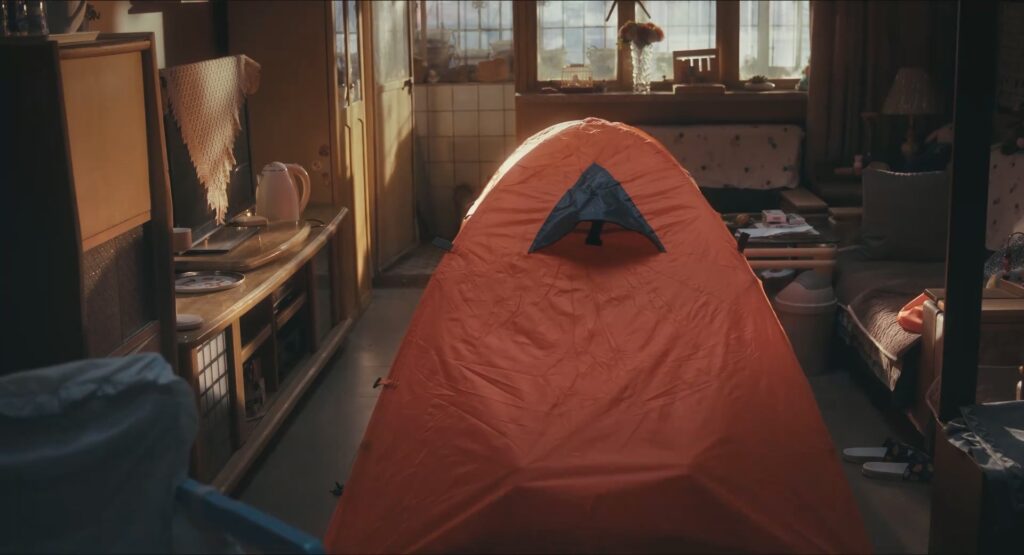
憋气的场景看多了(这里感谢姜武的爹味演绎^^),以至于会觉得,这算不算是电影不足的地方?——电影把生活环境描写得过于极端了,很多典型的生活困境,和典型的油腻男气息,都集中在一起。在我的想象里,这会让一些观影的人,因为自己并没有这么惨,而为自己找一些不出走的理由?譬如,很多家里老公会做饭,会给老婆打伞,多数家庭至少言语和睦,偶尔也能一起出去旅行,躺在床上刷手机的当然也不止是老公,女人也很多……于是,人们把电影和自己的现实一对比,哦,原来我没有那么惨,所以我没有出走,也是 ok 的。
但是,当我和别人说起这个想法时,发现对方的回应是:她老公已经算不错了,没有酗酒、家暴、吸毒、赌博、传销、网贷……虽然我觉得对方大概也是在开玩笑嘲讽,但每个人的认知底线也确实不同吧。我确实不擅长去想象别人的边界感。
现实中,我也会给身边困住庸碌生活中的人,家人、朋友、爱人,提供安慰,或者带他们玩各种有趣的东西。——这当然不是为了让他们更好地做牛做马;但是这些行为,会不会也为他们的各种意义上的「不出走」,加了一把力呢?我不知道。回想起来,很多次我带他们体验有趣事物的时候,真的在以一种希冀的目光看着他们, 希望他们突然说出, 不, 这样不够, 我还要更嗨。
然而并没有。
然后我发现就这么看电影时把自己看哭了。然后开始反思,我确实容易陷入这种「沉默的羔羊」式的自我感动,从起初想要不顾一切带着羊离开,到后来淡然着,看着羊们一次次地,偶尔露出些不清晰的对离开的憧憬,但很快又缩回去。——也可以理解成,被无形的文化之手抓了回去。而我对自己的淡然状态,是否应该又罪恶感呢?是否只是在享受廉价的自我感动呢?仍然不清楚。
讨论《一部未完成的电影》,朋友说,前面那些冗长的,十年前的回顾,是有意义的,是把当年那些美好的日子,和如今(片中的 2020 年)相对照;就像片尾曲,用了邵夷贝李志的《黄昏》,同样是让人回想曾经美好的时光。
笑。我突然意识到一件事情。对我来说,十几年前,并不是什么美好的过去,那时的我,已经确定这个体系无可救药,所谓「历史的垃圾时间」,早在那之前,就已经开始。然而,更年轻的人,或者「觉醒」的时间更后面一些的人,每个人都有各自认知中的「过去的美好时光」。十几年前,或者几年前,对他们来说,和更后面的日子相比,可能仍然是美好的,充满希望的。
而当对「美好时光」的时间点,有着相似的认知的人,彼此相遇,或者很多相似的人成为主流,他们之间的共鸣会更强一些。譬如导演认为 2010 年美好,而安排了这样的情节,那些同样认为 2010 年美好的人,就能感受到这一点。
这样的时间错乱的例子还有很多。
譬如,有人认为,新浪微博刚开始的氛围,也是很美好的。但对我而言,新浪微博出现的背景,是民间各种自建 twitter 网站被审查、夭折,然后大鳄们在尸横遍野中进场,之后的明星进驻,和原本的互联网风格相比,也很走偏。而且审查一直存在(限流和 shadow ban 大概是后来的新发明了……)。所以从来就不是什么好东西。
譬如,有《好东西》的粉丝,根据小孩的年龄,推算铁梅放弃做记者时,到底发生了什么?算出来是在 2014~15 年,「中国调查报导从初冬转向严寒」。——但那个时间点,真的没什么特别显著的事,中国新闻在那之前很多年,之后很多年,一直是严寒。
譬如,朋友说厌恶春节,因为当年武汉疫情时,万家宴的歌舞升平,给了他很大冲击。我想了想,类似的反差感里,让我冲击最强的,还是 2008 年汶川地震后,山东作协主席王兆山的诗,之后就大多是麻木了。
说这些,不是在倚老卖老,也不是在为自己的麻木做辩解;而是说,如果大家只是因为在觉醒的时间节拍上不搭,或者觉醒的姿势不大一样,而无法深切共情,是件完全可以理解的事情,不要因此而影响彼此的同温关系。
经常有人,很认真地问我:是什么时候、什么事情,让你的性别意识、或者反贼意识,觉醒的?问话的人,眼里闪着光芒,大概期待着我说出一些事件,然后说「呀,我也是」或者「我知道那个」,在共鸣中进一步增进友情。然而对我来说,确实不存在某个明确的觉醒时刻,就是从一开始就怀着最朴素的正义感,在各种事件熏陶中,一点点加深认识。但这样的说法,似乎经常让对方不满意?我也不知道要怎样处理这些。
跟女孩子骑了一程重型摩托车,渐渐发现,每次她在红灯路口停下来时,动作都很一致:左脚撑地,右脚踩住刹车,——但这样的姿势,如果离合器在空档位,是没有办法直接从静态起步的,所以这段时间,其实是挂在一档,左手要一直捏住离合器。感觉手很累。
相比之下,我的动作则散漫很多。停车时我通常会右脚撑地,离合器挂在空档,左手完全松开,启动时用左脚踩进一档,然后直接前进。——但这种姿势和地形有关,如果停在斜坡上,车子前后溜动,缓一点的坡,可以勉强用脚撑住;陡一点的坡,就需要用右手捏住刹车,而捏久了觉得累,就也切换成右脚踩刹车,左脚踩地的姿势,但此时已经是空档了,启动时需要先换成右脚踩地,未免手忙脚乱。
但女生骑重机的最大问题在于,240kg 的摩托车,倒了是真的扶不起来。而任何车身的不稳、摇晃、倾斜、甚至一阵强风吹来,也都会导致撑不住,而最终倒下。所以,我的那些(勉强用脚撑住、换脚踩地、手忙脚乱)的情景,对她们而言,是完全不允许出现的状况。于是,这种停车时,手一直捏住一档离合的姿势,大概是适用于所有情况的统一最优解?我这种野路子出身,并不知道这样的姿势,是对方长年骑车的自我经验总结,还是经过了一套「女生如何骑重机」的专门学习培训?回头问问去。
另一方面,这种容错率很低的,对远超自己体重的机械驾驭,在骑行过程中,是否在精神上也是一种时刻紧绷的状态,当心自己随时会翻倒?——大概是的。虽然不同人在精神紧绷程度上存在差别,但应该不会像我那样散漫放松。而我也时常会忽视这种差别,停车时发现对方后座行李歪了,顺手扶了一把,却给对方造成了惊吓。
对方骑重机的效果,确实是非常的帅!对车子的驾驭技术也比我好,为了能骑上这么帅的重机,所付出的努力,也肯定比我多。——那么,设身处地,从我个人的角度,换做我是那个体重轻的女生,我是否愿意为了骑重机,而投身到更多的规则和努力之中?
从这个角度分析下去,其实和「女性生存状况」、以及「在日本生活的方式」,其思路上都有些隐喻的成分。当然,首先要批判的是环境因素:
在承认这一点的基础上,从文化规训、以及个人选择的维度上,
待续。
标题致敬 David Graeber 《规则的悖论》,但目前想写的这些,大概和书里的内容没什么关系。
湄洲岛,传说是妈祖林默的故乡。北宋年间,岛上出现了最早的妈祖庙(灵女祠),经历朝扩建为大片宫殿,文革期间全毁,1980 年代后,由散落到各地的香火信徒集资重建的仿宋建筑群。被妈祖信徒们戏称为「东方麦加」……
除了在码头附近的大型祖庙外,湄洲岛上的几乎每个村落,都有各自的妈祖庙,盖的都不小。去不同的堂口进香,也是信仰和交流体系的一部分;尤其是在一些祭日,人们会扛着妈祖像,把所有的庙都逛一遍。
但其中一些庙,路不熟的话,并不好找。于是我上岛时,被唤醒了踩地图之魂,骑着电动车,把所有妈祖庙都找了一遍,标上准确的 GPS 位置。
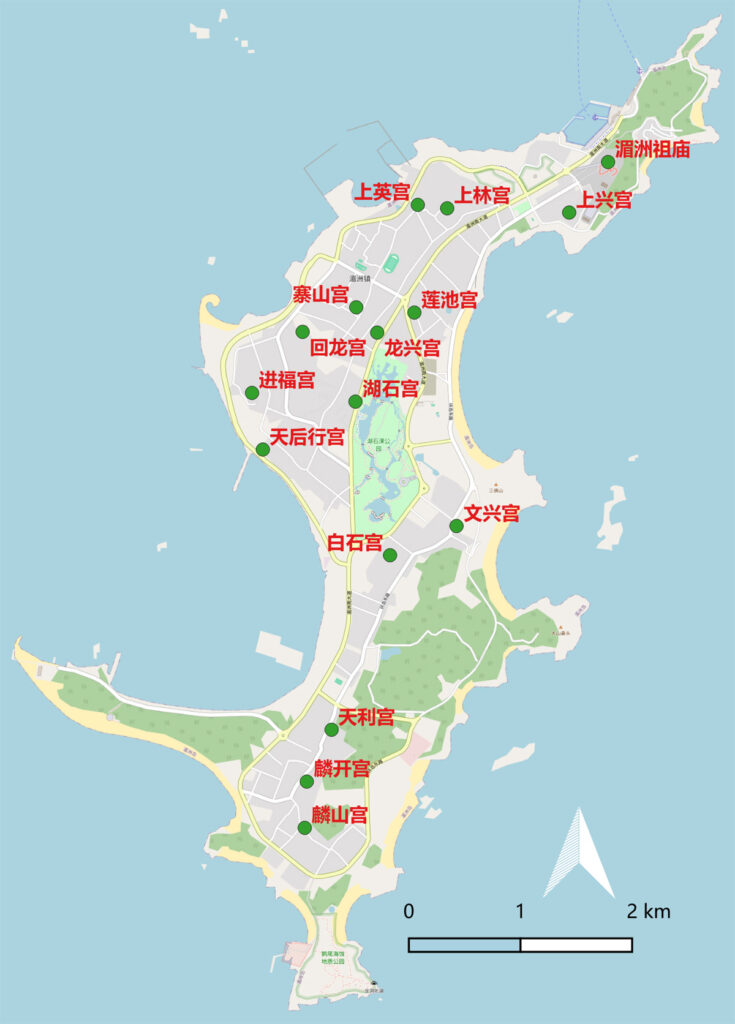
每座庙的 GPS 位置(WGS 84),由北向南:
| 地点 | 纬度 °N | 经度 °E |
|---|---|---|
| 湄洲祖庙 | 25.09379 | 119.14317 |
| 上英宫 | 25.09035 | 119.12628 |
| 上林宫 | 25.09007 | 119.12889 |
| 上兴宫 | 25.08973 | 119.13972 |
| 寨山宫 | 25.08211 | 119.12082 |
| 莲池宫 | 25.08169 | 119.12598 |
| 回龙宫 | 25.08014 | 119.11606 |
| 龙兴宫 | 25.08008 | 119.12268 |
| 进福宫 | 25.07523 | 119.11157 |
| 湖石宫 | 25.07453 | 119.12075 |
| 天后行宫 | 25.07068 | 119.11253 |
| 文兴宫 | 25.06453 | 119.12972 |
| 白石宫 | 25.06218 | 119.12382 |
| 天利宫 | 25.04815 | 119.11863 |
| 麟开宫 | 25.04398 | 119.11643 |
| 麟山宫 | 25.04026 | 119.11625 |
大约有一半的妈祖庙,是比较好找的,就在主路的边上,甚至在高德地图就能搜到。但其中也有坑,譬如,我第一个去的是「莲池宫」,按地图上搜到的位置,找过去,却关了门。因为是第一家,我并不知道岛上的庙,是什么样子的,于是以为自己不走运,很多庙不在祭日都会关门;正在遗憾,看到里面仿佛有人,敲门问了问,才发现,这家莲池堂,其实是个耶稣教会………
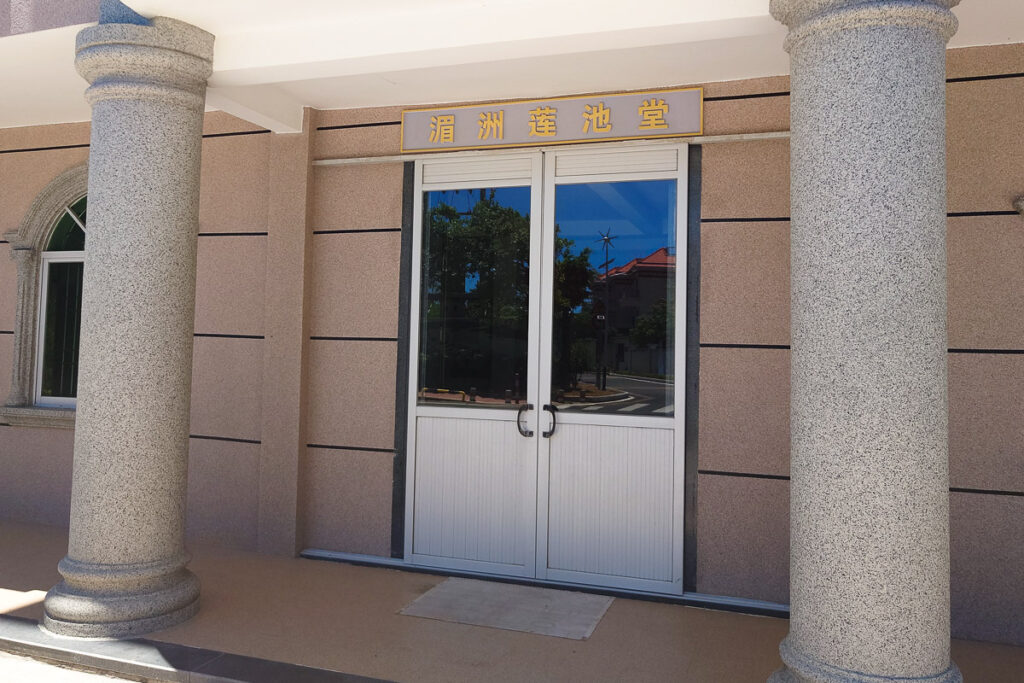
真正的莲池宫,藏在另一个方向的村子里,穿过几条土路才会看到。所有的妈祖庙,其实都是这种金碧堂皇的样子,平日一直开着门。
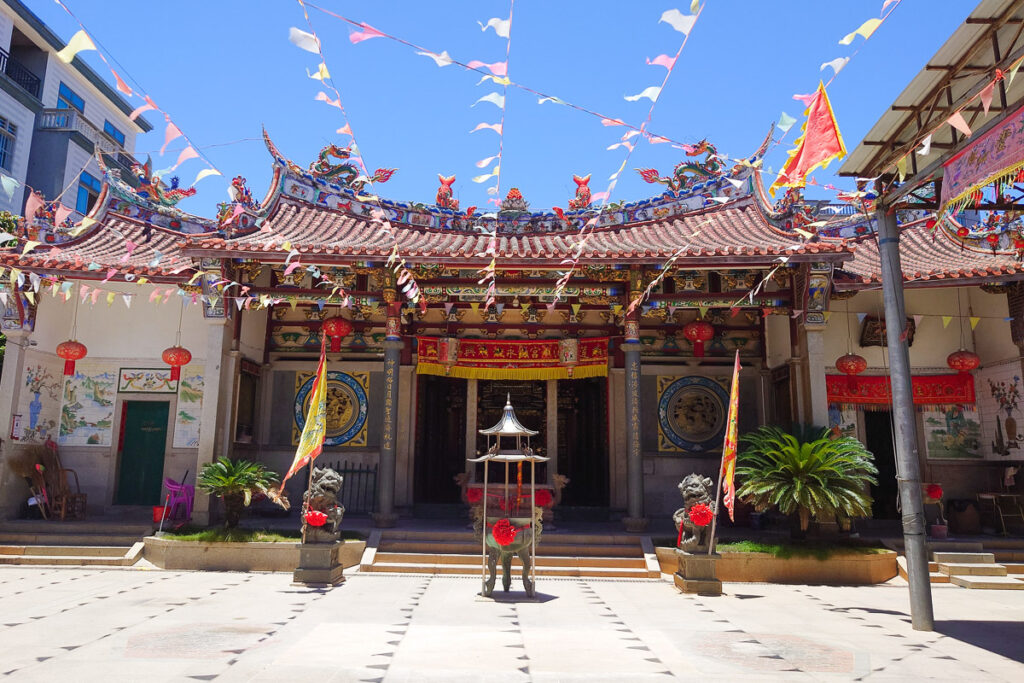
岛上还有很多其它的庙:有耶稣教会、有完全不供奉妈祖的佛寺、有很小只的土地庙、关帝庙、海神庙、有家族私姓的祠堂、有看着很像妈祖庙,但不知是做什么的「三一教」……海边的「天后行宫」,在妈祖庙背后,修了个更大一号的如来大雄宝殿,于是感觉并不是很靠谱,有人介绍岛上除了祖庙,有 15 家妈祖庙,就没有把天后行宫算在里面。
但有些神灵,是可以放在妈祖庙的侧位一起供的,譬如,齐天大圣……
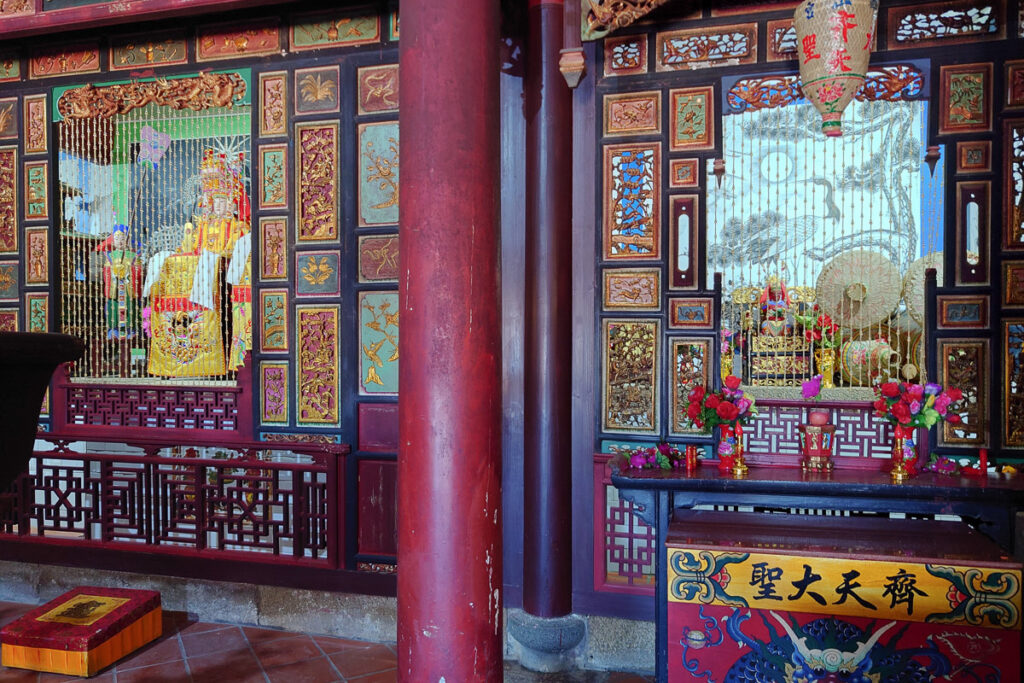
有的庙正在修葺,就让妈祖像暂居到村子的土地庙/城隍庙里,因为妈祖更大牌,所以城隍要把中间的位子让出来~
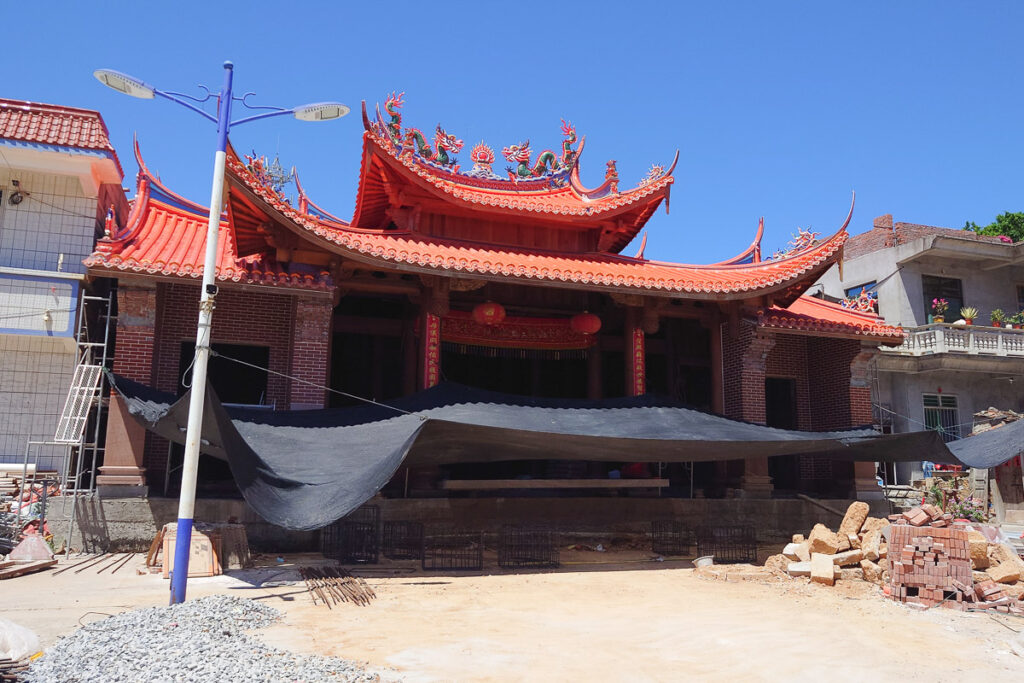
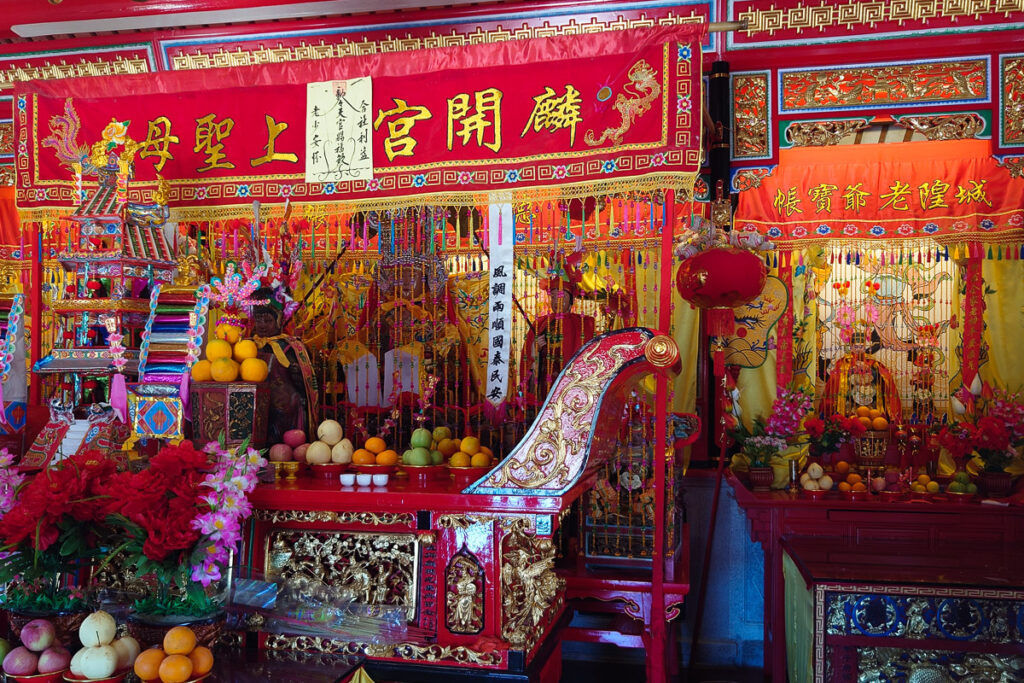
有的已经建好了新庙,于是旧庙广场上,用来晒鱼干。
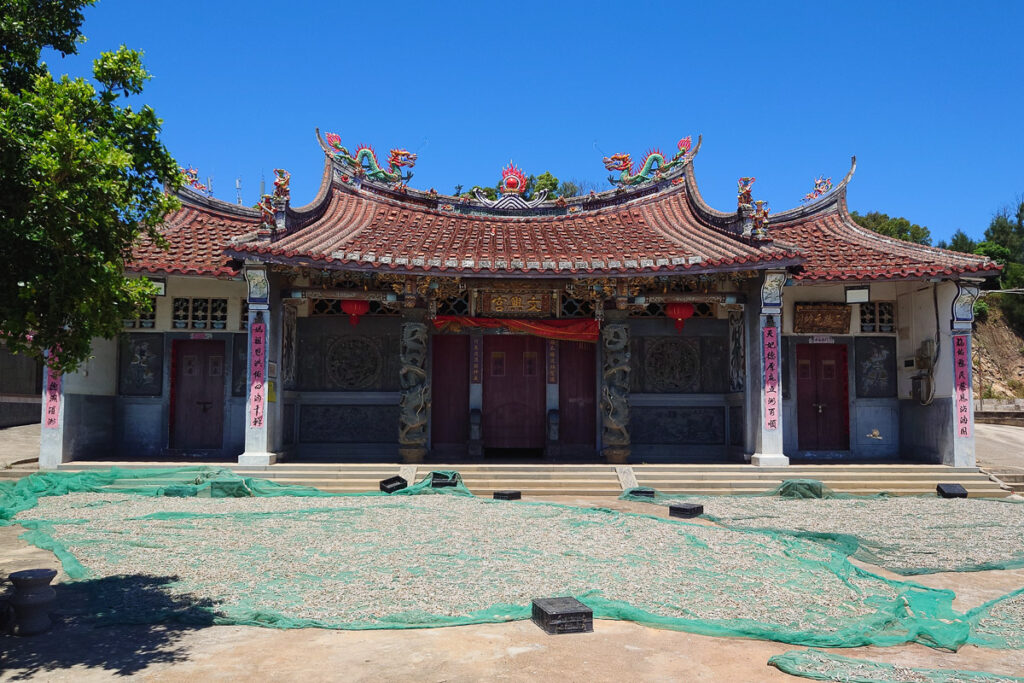
所有的庙旁边都有戏台,还有很多社区的老年中心,也挂牌建在庙场旁边。但大家也经常直接在庙里活动:织网、打牌……赌金还不小。
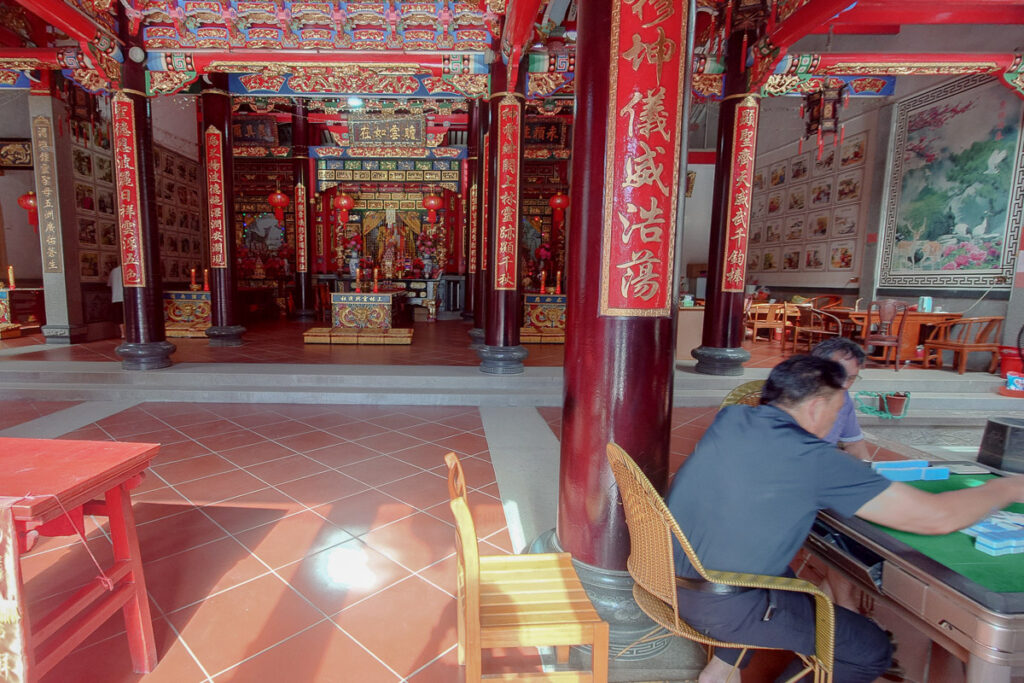
庙修的都很精美,但赞助者的签名,就磕碜了点儿。
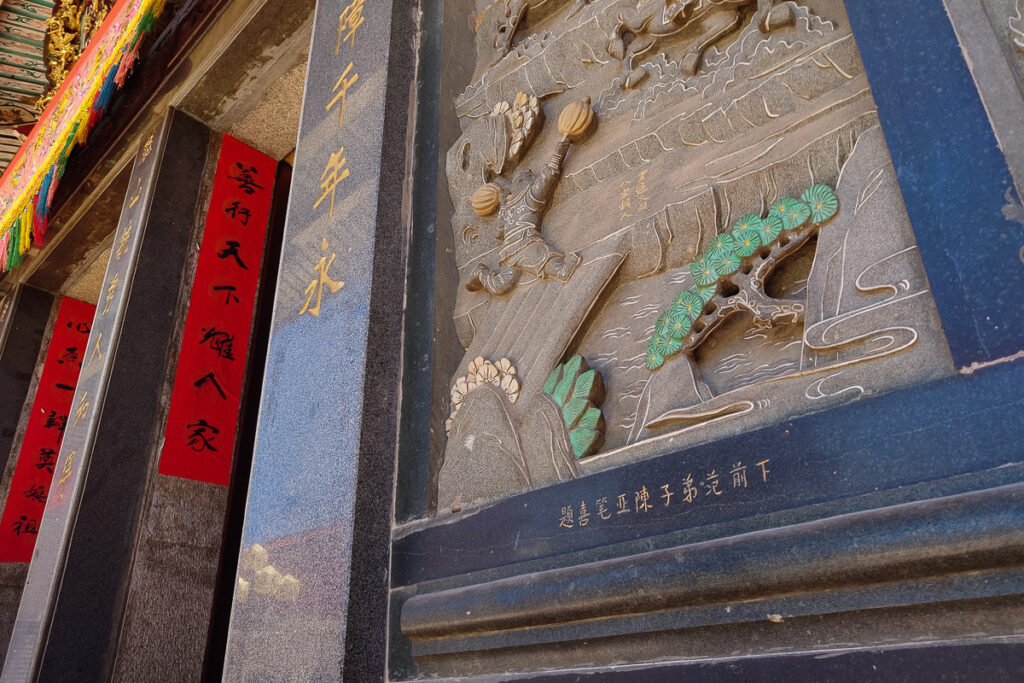
希望小朋友考出好成绩。
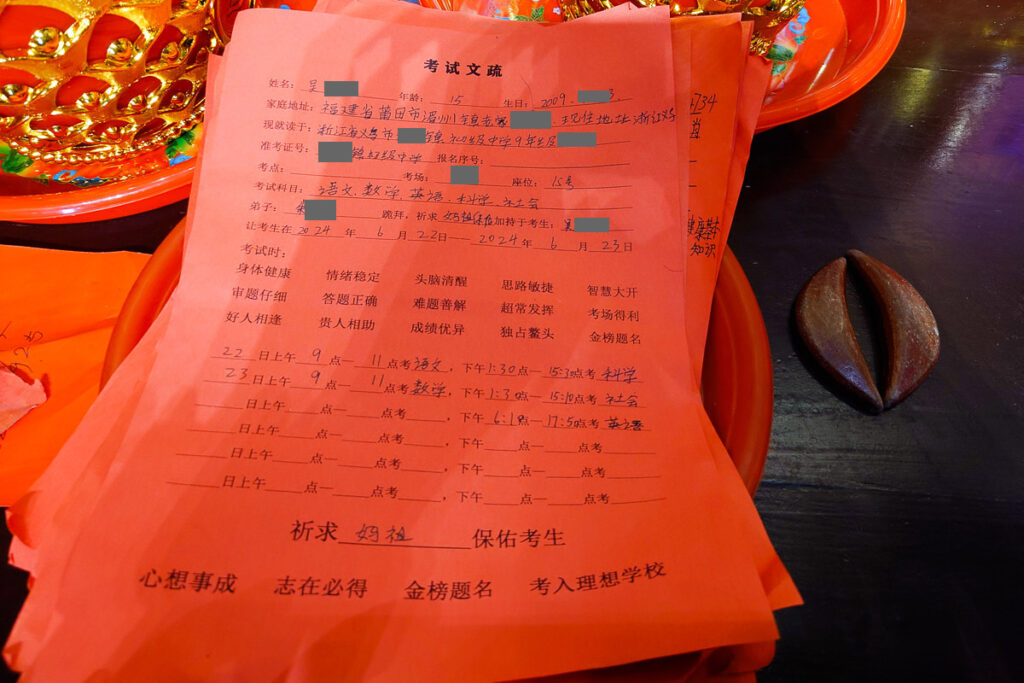
路过其它小庙在举行仪式,搭台唱戏。但感觉不同信徒之间,是有些隔绝的。很多时候问路,几百米外的妈祖庙,对方并不知道在哪里,甚至没听说过。
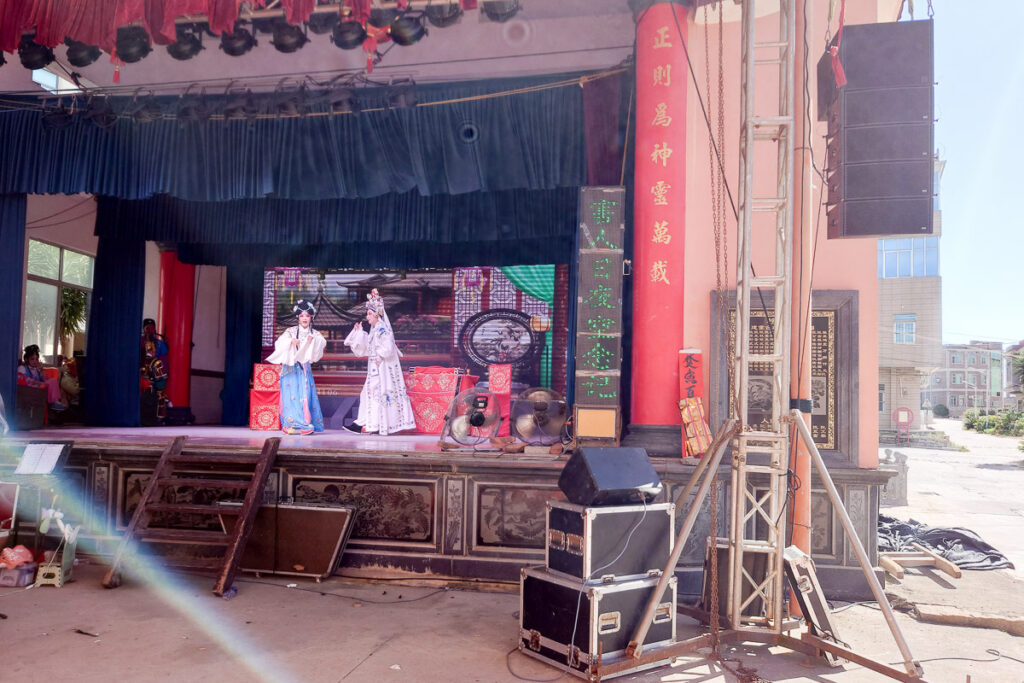
岛上有很多游客、有夜市、很漂亮的画了彩虹线的海边公路。游客们穿着小清新的样子,打卡拍照。但似乎很少有人会去这些庙里逛逛。似乎是两个世界。
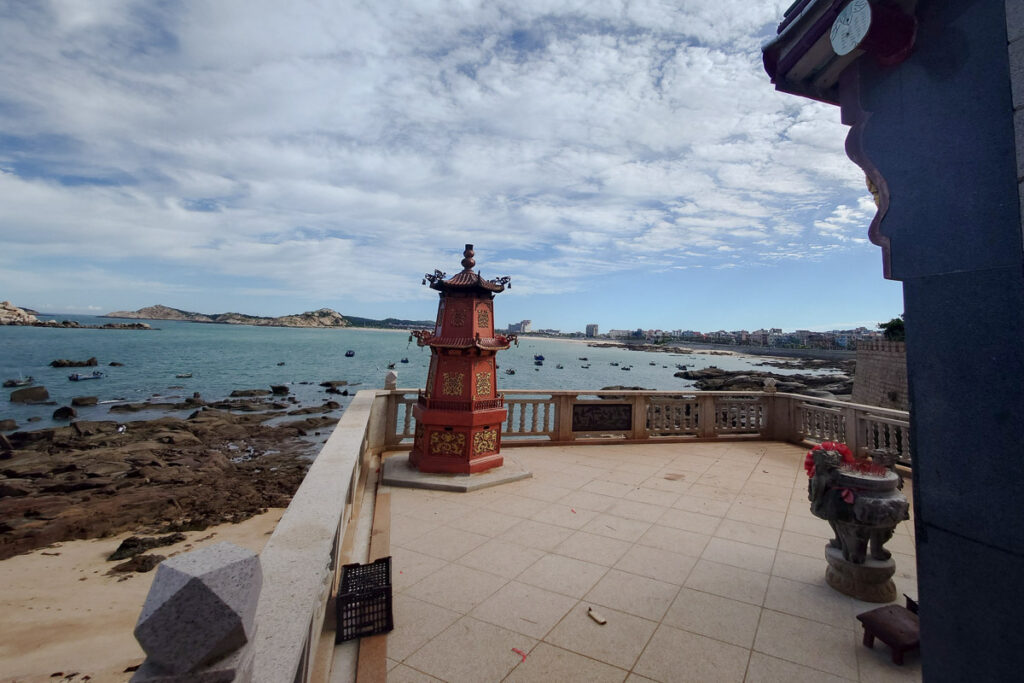
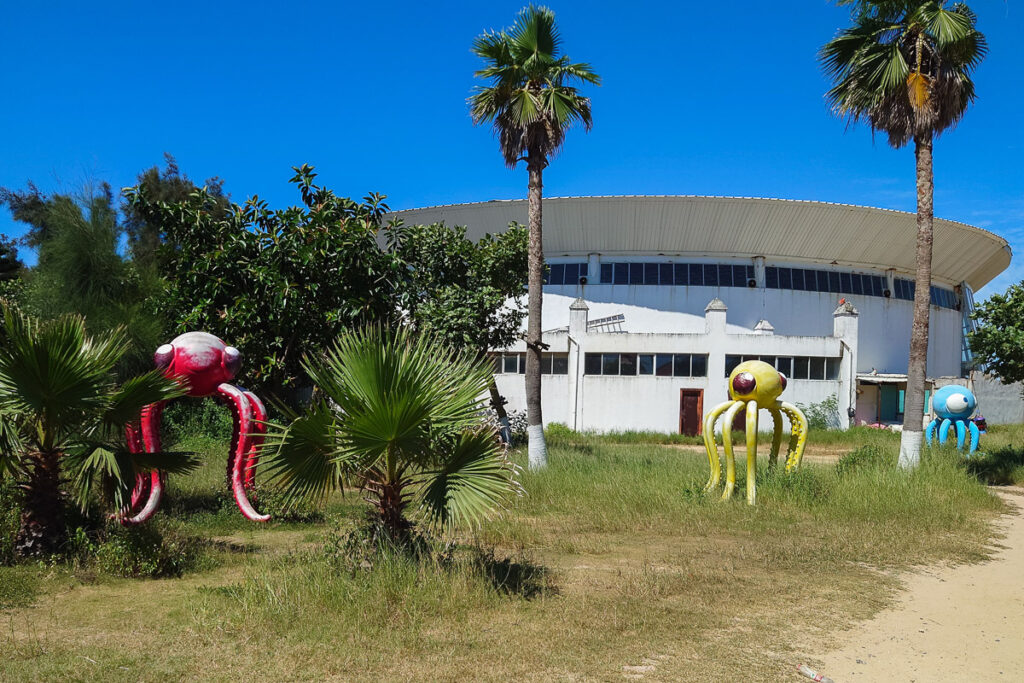
观影会上看纪录片,流亡的巴勒斯坦妇女们,合作编织一条传统工艺的挂毯,以此为线索,把个体的流亡叙述,联系在一起。电影拍的不错。观影者们,也纷纷映照自身经历,讨论各种美好的文化,被战争或强权摧残,是多么可惜;以及作为物理或精神上的流亡者,如何从文化叙事的角度,相互连接、支撑。进而强调口述性历史的学术意义。
然而,几乎所有的反映难民的作品或讨论,都是类似的视角,赞扬受害者原先的文化或者美好的生活,从而凸显破坏这些的行为,是多么的不义。
这样的视角看多了,忍不住想:从摧残文化的角度去谴责战争,真的是合理的么?
1.
我所在的文化里,有很多糟粕、或是庸碌,是我们日常在坚持努力抵抗着的。读到这篇文章的人,同样也有很多,是日常和这些文化氛围对抗着的少数派。如果有一天,我们也遭遇战火,成为难民,那么,在这个关于难民或离乡者(diaspora)的叙事中,我们之前在群体内部的反抗,那些苦苦坚持着的自我,就,消失了?变得全无意义?甚至,在和 diaspora 同温层的交流中,仅仅是提到这些,都变得不应该?
关于 diaspora 如何不自觉地被迫形成群体性,以对抗整体的政治性,在学术界大概也不是什么新鲜话题。我只是从被湮没的个体的角度,又一次想到这些。
2.
:这部电影让我很感动……我不想让我所在的文化,或者我自己,从历史上消失,被抹去。
:我也很感动,——但是,如果,我不在乎自己没有留下任何痕迹。这样的我,仍然会面对不公而反抗,也会为遭受不公的你们去反抗,那么,我的这些反抗,是否会因为我不想坚持自己的传统文化,就变得更弱一些呢?
就像我不是因为自身利益才支持女性主义那样,我反抗的,是更纯粹的不公。而不是什么相关利益,或者附加的理由。
3.
我承认,在难民群体中,用文化来团结大家,保持连接,在人们的现有认知中,是很有效的方式。但是,这样的操作,平空又多了一道工序:对自身文化的美化和维护。网上关于巴勒斯坦、乌克兰、乃至香港的争论,很多也都流于这个模式——
黄丝:香港原有的美好传统,被摧残得不剩什么了。
小粉红:就你们那点破传统,譬如啥啥啥陋习,有什么可保留的?(这里的很多例子,其实我是同意的……)
黄丝:艹,你们的啥啥传统才叫做垃圾,blah blah
然后争论的重点,就歪成了「这个文化是否足够好,是否值得保留。」——然而,如果这个被摧残的文化,它不够好,那么它反抗强权的合理性,就会减弱吗?
我还以为这篇早就写成 blog 了,想引用的时候,却发现并没有。当年只是在 mastodon 发了一条。那么还是贴过来吧。感觉最近想写的很多话题,都与之隐约关联。回头再慢慢展开(大概会写一堆「同温层里标榜个人主义」的画风……
(2022年,疫情后,谈论「润」的人自然渐渐多起来。)
这段时间关于「润」的讨论,无论只是讨论,还是已经在行动,给我的感觉,更偏向于一种「被迫」才考虑的状态。社区里,大家经常交流,过去的哪个事件,成为了下决心跑路的底线。——于是联想到自己。但感觉我当时,并没有这样的底线事件,或者说,远远不是到底线才润的,甚至也不是为了更好的生活水准;仅仅是护照可以方便去更多地方,以及不想让自己说话时受委屈。
这正是我这些年怨念的地方:各种动荡下,原先那种「为了探索新世界才做啥啥」的情怀,没人谈起了;一切都塌缩回「保障自己物质或情绪上生存」为导向的行动策略。以至于,我期待的,原先为了探索的人终于聚在一起讨论的内容,也变成了被迫跑路后讨论如何在异地找个稳定工作。——熟悉我的人应该知道,我并不是在物质无忧的条件下说这种风凉话的。事实上,需要把物质前提,在意到什么程度,本身也是文化导向和自我审视的结果。总之就是希望大家能更好玩一些。
关于车里用的燃气炉灶方案。因为只是简单的 van,而不是正式的房车,不存在内嵌的燃气系统,只是每天把各种气罐炉头搬来搬去。简要地说,每天使用最多的方案是:
从大号液化石油气罐(POL),先转成美式一磅罐卡口(UNEF 1″),再转接到户外圆罐炉头(Lindal B188)上。
这样的组合,可以随时把其中的一些环节,替换成其它款式的气罐和燃气用品。
户外常见的气罐接口,大概有这五种:

① POL,也就是最常见的大号「煤气罐」,准确地说,叫「液化石油气罐」。我这边日常可以买到的,有 3.7kg 和 8.5kg 两种容积。大的更划算,但我的床板下面只能放进小号的,换一瓶气大约 $20,Bunnings 和很多加油站都有换。
还有一种 LCC 27 接口,是 POL 的升级版。近年来政府渐渐把 POL 气罐,升级成更安全的 LCC 27 接口。这个是向下兼容的:原先用在 POL 上的管线,仍然可以拧进 LCC 27 的气罐;反之则不行,LCC 27 专用的管线,不能用在 POL 气罐上。所以,使用 POL 的管线,就不必在乎每次换到的气罐,是旧接口还是新接口。

② 3/8″ BSP-LH,另一种大号石油气罐的接口,通常只有专门的户外型房车才会使用。加油站很少见,更换气瓶也远不如 POL 方便。可以很方便地改成 POL,户外店有转接头卖($15)。
③ UNEF 1″ / BOM,北美常见的一磅重的绿气罐,北美的加油站和便利店到处都是,但澳洲和中国很少,只有专门户外店才有。
④ Lindal B188,又名 7/16 UNEF,户外背包露营时,最常见的扁圆气罐。虽然北美有很多炉头,都是 ③ 的 UNEF 接口,但毕竟 UNEF 接口过于笨重,自己背而不是车载露营的话,国际通用的炉头,更多的还是 ④ 的接口。
⑤ 常见的火锅店长气罐。虽然工艺远不如 ③ ④,但是更便宜也更好买,所以很多用 Lindal 圆罐炉头 ④ 的人,都会常备一个 ⑤→④ 的转换头($5)。(长罐到美式一磅罐 ⑤→③ 的转接头我从来没见过,大概因为美式罐太笨重了)
还有一些不常用的接口,譬如和 ④ 很像但是不带螺纹的气罐、以及一些笨重烧烤台用的 1/4” BSP……与本文无关,就不面面俱到地提及了。
一张图显示我日常的炉灶系统:

于是,日常使用最多的组合方案,包括:
日常煮食时,炉头和锅放在旁边的桌板,或者直接放在地上也可以。并不需要专门把气罐搬出来用。
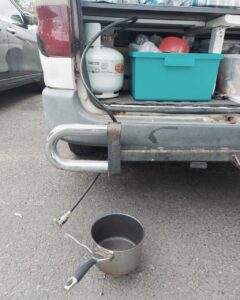
其它车内需要用到燃气的装置,还有:
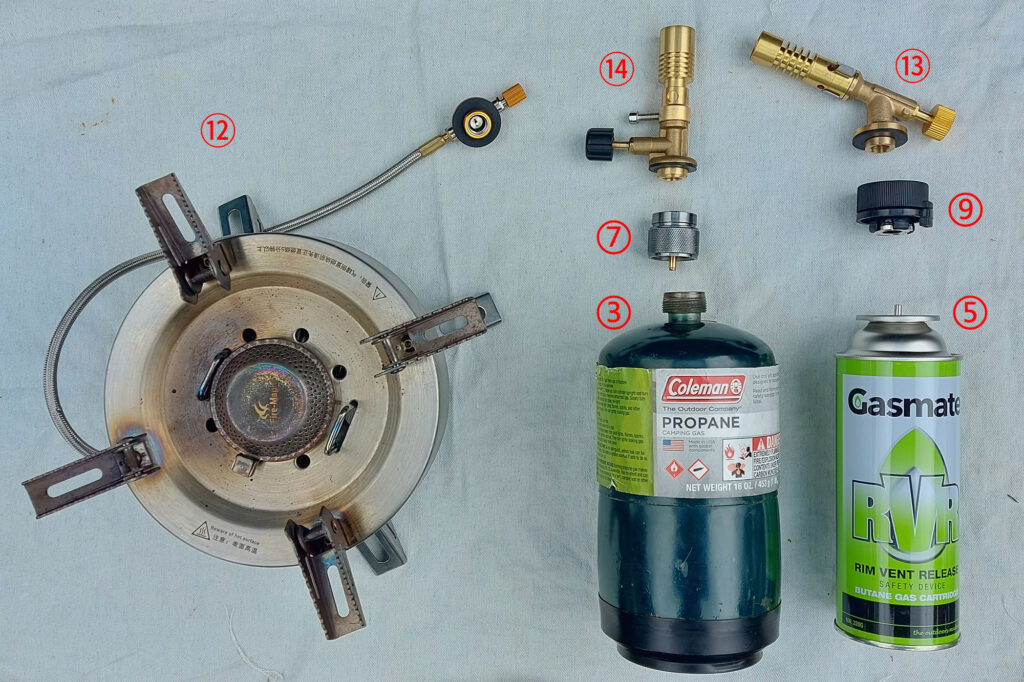
以及,必须的,一氧化碳监测仪,$25

ps,关于灌装。所有的一磅罐、户外圆罐、火锅长罐……厂家都是禁止用户自行灌注燃料反复使用的。但所有这些罐子,都存在着自行灌装的黑科技,以及相应的很便宜的转接头卖。其中美式一磅罐因为自带减压阀,比其它罐子更安全一些。个人感觉重复灌几次,还是没问题的。网上也不乏号称一个罐子反复用了一辈子的。但我还是不推荐读者贸然使用,请自行斟酌。如果只是偶尔用一下小罐子,多买几个一次性火锅气罐也就是了。

卖转接头的网店图。——但是连卖家的演示图,也是错误的。灌装时应该把大罐子倒置,让沉在下面的液态的石油气流进小罐子,而不仅仅是挥发的气态。